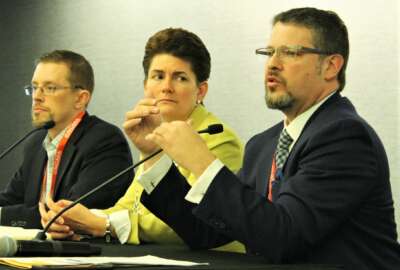

When it comes to gathering data, the National Oceanic and Atmospheric Administration is one of the most network-intensive agencies you’ll find.
When it comes to gathering data, the National Oceanic and Atmospheric Administration is one of the most network-intensive agencies around.
“The network consists of a little over 2,100 locations,” Jeff Flick, the Acting Director of NOAA’s Enterprise Network Program Office, said on Federal Insights — EIS. “Just around 400 of those locations are manned locations.”
There are super-computing sites, which require low latency, high bandwidth-type environments, all the way down to remote sensors that require very little bandwidth. This presents a challenging environment for telecommunications, and Flick suggested the time has come to replace the current infrastructure at NOAA.
“Some of the technologies are, I don’t want to say archaic, but they’re very resilient, because we’ve had them for so many years,” he told Federal Drive with Tom Temin. “But with the TDM retirement, we’re being forced to upgrade various legs of those pathways to more modern technologies, which force the evolution of sensory technology as well.”
TDM stands for time division multiplexing, “the older, copper infrastructure that is being retired by the carriers,” he said. In the future, NOAA is looking to move into wireless opportunities where that’s available.
“Some of the locations where we have these remote sensors are not densely populated areas, which means they’re low priority for wireless coverage,” Flick said. “So we’re looking at if needed satellite technologies at this point have advanced and the cost have been reduced enough where that might be a viable solution for some of the remote locations or looking at alternatives: low bandwidth, low frequency.”
He said that the industry is trying to retire electronics that support older technologies, and transition to fiber or other access methods. NOAA is in the midst of developing its replacement throughout its vast “very distributed” environment. It’s an agency with an “extreme network infrastructure” multi-hundred gig, redundant connections all over the U.S. from a large facility in West Virginia to resources in New Jersey, Maryland, and other contracted sites.
“We’re just trying to make sure that they have the best choices available. And what does that mean? We have the opportunity to provide high-quality services to those individual programs and they can choose from networking programs within the agency. And then those providers utilize EIS to provide that level of support.”
Flick addressed the timeline with the assurance it is all being done methodically.
“As we move to the award phase of this acquisition with EIS, the vendor will have to be able to support many priorities, the operational priorities as well as the research and administrative priorities.”
As the acquisition phase moves forward, Flick expects to limit the number of vendors.
“Today we have almost 300 vendors providing telecommunications across the agency. And we need a smaller number to manage.”
NOAA will need a vendor that is capable of handling a wide range of situations from satellite down links and forwarding of that data to cat six, within a building.
“We’re fortunate that EIS provided all of that within the scope of that contract and we’ll be looking to take advantage of that,” Flick said.
EIS will be replacing NOAA’s legacy contracts, moving from one to the other.
“Quite a bit of our current spend is on the legacy contracts,” Flick said. “About 60% of our spend is there and so we anticipate all that will transition over onto EIS task orders once they’re awarded.”
NOAA is currently evaluating solicitations and expects to award a contract by the end of 2020.
“Outside of the technical components that each vendor had to achieve to be on EIS we’re looking at the transition approach and the management approach,” Flick said.
But modernization means more than technology — it’s about management as well. Networking as a service, or managing one’s own own network infrastructure and voice telecommunications, all varies from within each organization.
“It’s really the opportunity to simplify it for them, let them focus on their mission. But we’re allowing a lot of that decision still to be made at the mission level,” Flick said. “And my focus is really making sure that we have the right type of support structures, contracts, and technical resources available to support them.”
Copyright © 2025 Federal News Network. All rights reserved. This website is not intended for users located within the European Economic Area.
Peter Musurlian is a producer at Federal News Network.
Follow @PMusurlianWFED



